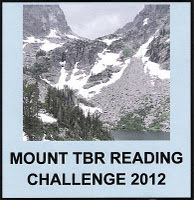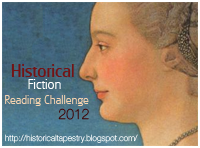Dana Swier Huff's Blog, page 52
July 15, 2012
Food Nonfiction
I love reading about food. It is interesting to learn how certain food items are entwined with history and impacted world events as well as how they became so important to culture as well as our diet. We are what we eat, right? Here is a collection of books about food that I’ve put on my tbr pile:
 One of my friends has described this book as one of the best she’s ever read. Salt: A World History by Mark Kurlansky is a story about the history and importance of salt. From Goodreads:
One of my friends has described this book as one of the best she’s ever read. Salt: A World History by Mark Kurlansky is a story about the history and importance of salt. From Goodreads:
Kurlansky “turns his attention to a common household item with a long and intriguing history: salt. The only rock we eat, salt has shaped civilization from the very beginning, and its story is a glittering, often surprising part of the history of humankind. A substance so valuable it served as currency, salt has influenced the establishment of trade routes and cities, provoked and financed wars, secured empires, and inspired revolutions. Populated by colorful characters and filled with an unending series of fascinating details, Kurlansky’s kaleidoscopic history is a supremely entertaining, multi-layered masterpiece.”
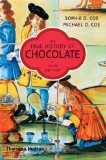 I actually have The True History of Chocolate by Sophie D. Coe and Michael D. Coe on my shelf right now. I looove chocolate. Who doesn’t? Goodreads says,
I actually have The True History of Chocolate by Sophie D. Coe and Michael D. Coe on my shelf right now. I looove chocolate. Who doesn’t? Goodreads says,
This delightful and best-selling tale of one of the world’s favorite foods draws upon botany, archaeology, and culinary history to present a complete and accurate history of chocolate. The story begins some 3,000 years ago in the jungles of Mexico and Central America with the chocolate tree, Theobroma Cacao, and the complex processes necessary to transform its bitter seeds into what is now known as chocolate. This was centuries before chocolate was consumed in generally unsweetened liquid form and used as currency by the Maya, and the Aztecs after them. The Spanish conquest of Central America introduced chocolate to Europe, where it first became the drink of kings and aristocrats and then was popularized in coffeehouses. Industrialization in the nineteenth and twentieth centuries made chocolate a food for the masses, and now, in our own time, it has become once again a luxury item. The second edition draws on recent research and genetic analysis to update the information on the origins of the chocolate tree and early use by the Maya and others, and there is a new section on the medical and nutritional benefits of chocolate.
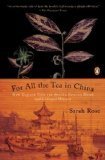 For All the Tea in China by Sarah Rose is currently on my Kindle. I love tea. I love teapots. I love everything about a traditional British tea. This book, however, makes the story of tea sound like an adventure. Goodreads describes the book:
For All the Tea in China by Sarah Rose is currently on my Kindle. I love tea. I love teapots. I love everything about a traditional British tea. This book, however, makes the story of tea sound like an adventure. Goodreads describes the book:
Robert Fortune was a Scottish gardener, botanist, plant hunter—and industrial spy. In 1848, the East India Company engaged him to make a clandestine trip into the interior of China—territory forbidden to foreigners—to steal the closely guarded secrets of tea. For centuries, China had been the world’s sole tea manufacturer. Britain purchased this fuel for its Empire by trading opium to the Chinese—a poisonous relationship Britain fought two destructive wars to sustain. The East India Company had profited lavishly as the middleman, but now it was sinking, having lost its monopoly to trade tea. Its salvation, it thought, was to establish its own plantations in the Himalayas of British India. There were just two problems: India had no tea plants worth growing, and the company wouldn’t have known what to do with them if it had. Hence Robert Fortune’s daring trip. The Chinese interior was off-limits and virtually unknown to the West, but that’s where the finest tea was grown—the richest oolongs, soochongs and pekoes. And the Emperor aimed to keep it that way.
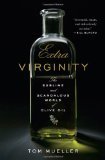 I was doing some research on olive oil the other day, and I came across Extra Virginity: The Sublime and Scandalous World of Olive Oil by Tom Mueller, and I have to admit I was intrigued. A whole book in olive oil? Apparently so:
I was doing some research on olive oil the other day, and I came across Extra Virginity: The Sublime and Scandalous World of Olive Oil by Tom Mueller, and I have to admit I was intrigued. A whole book in olive oil? Apparently so:
For millennia, fresh olive oil has been one of life’s necessities—not just as food but also as medicine, a beauty aid, and a vital element of religious ritual. Today’s researchers are continuing to confirm the remarkable, life-giving properties of true extra-virgin, and “extra-virgin Italian” has become the highest standard of quality.
But what if this symbol of purity has become deeply corrupt? Starting with an explosive article in The New Yorker, Tom Mueller has become the world’s expert on olive oil and olive oil fraud-a story of globalization, deception, and crime in the food industry from ancient times to the present, and a powerful indictment of today’s lax protections against fake and even toxic food products in the United States. A rich and deliciously readable narrative, Extra Virginity is also an inspiring account of the artisanal producers, chemical analysts, chefs, and food activists who are defending the extraordinary oils that truly deserve the name “extra-virgin.”
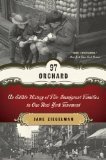 97 Orchard: An Edible History of Five Immigrant Families in One New York Tenement by Jane Ziegelman has been on my list for a long time. Goodreads says,
97 Orchard: An Edible History of Five Immigrant Families in One New York Tenement by Jane Ziegelman has been on my list for a long time. Goodreads says,
This delicious saga of how immigrant food became American food follows European immigrants on a remarkable journey from the Ellis Island dining hall to tiny tenement kitchens, from Lower East Side pushcart markets and delicatessens out into the wider world of American cuisine.
Although reviewers have mentioned the book isn’t really about the immigrant families so much as it is about the kinds of food immigrants brought to America and that the single tenement was more an organization device than anything else, I still really want to read it. Just reading the description from Publisher’s Weekly makes me hungry:
Ziegelman puts a historical spin to the notion that you are what you eat by looking at five immigrant families from what she calls the “elemental perspective of the foods they ate.” They are German, Italian, Irish, and Jewish (both Orthodox and Reform) from Russia and Germany—they are new Americans, and each family, sometime between 1863 and 1935, lived on Manhattan’s Lower East Side. Each represents the predicaments faced in adapting the food traditions it knew to the country it adopted. From census data, newspaper accounts, sociological studies, and cookbooks of the time, Ziegelman vividly renders a proud, diverse community learning to be American. She describes the funk of fermenting sauerkraut, the bounty of a pushcart market, the culinary versatility of a potato, as well as such treats as hamburger, spaghetti, and lager beer. Beyond the foodstuffs and recipes of the time, however, are the mores, histories, and identities that food evokes. Through food, the author records the immigrants’ struggle to reinterpret themselves in an American context and their reciprocal impact on American culture at large.
Food is one of those things that shapes our culture in so many ways. We also derive so much of who we are from the food we eat. I was listening to an Italian-American colleague at work the other day telling a co-worker he never had macaroni and cheese as a child because it was “boxed pasta,” and his mother wouldn’t have it in the house. I don’t think I ever had pasta that wasn’t from a box unless it was at a restaurant. I know folks who swear by homemade pasta and spend the time to make it, but would I know the difference? I don’t know what I’m missing. Chances are pretty good, however, that my colleague doesn’t know good Southern fried chicken.
So, do you have any good books about food? Please share.
[image error]
Post © Dana Huff
Food Nonfiction
July 1, 2012
Moving Books
We (finally) received our belongings after two weeks of waiting. A word to the wise: Never use Summit Van Lines. The estimate was well below the final cost, and while I understand an estimate is an estimate, I think it should be close to the cost. They were hard to communicate with. Sometimes it took multiple tries to reach them. Our goods were only delivered after I complained. Finally, our boxes were all crushed, and I attribute the fact that nothing (so far—still unpacking) was broken to the fact that I packed the breakables myself. Had they done it, I’m sure it would have been broken. They also tried to charge us for having stairs, but their boilerplate specifically says there is no charge for stairs, so we put our feet down.
One of our movers asked us why we had so many books.
As if that’s weird or something.
We have more book boxes than anything else. Steve took the picture above of our book boxes. We haven’t unpacked them yet because we have a plan for organizing them, and I imagine they’ll be the last things we unpack. So far we have the kitchen and bathroom done, and we are making serious headway on the master bedroom.
I went to San Diego for an educational technology conference with my new colleagues at Worcester Academy, and I won a Kindle Fire! I am trying to figure out how I will best use it. I like the idea of putting mainly books with color images on it, or perhaps using it for periodicals. I want to share it with family, but I’m also concerned that will be hard because one or the other of us might be using it for a book and not want to hand it over. Anyone try to share a Kindle? Did it work? If you have a Kindle Fire, how do you use it? What do you like about it?
[image error]
Post © Dana Huff
Moving Books

June 20, 2012
Basic Soap Making, Elizabeth Letcavage and Patsy Buck
 Basic Soap Making by Elizabeth Letcavage and Patsy Buck is a quick, easy-to-read basic instruction manual for beginners to homemade soap making. The book includes basic instructions for several kinds of soap as well as great information about handling lye and making your own mold and cutter (those wooden molds are very expensive!). The photographs are great, and the step-by-step directions seemed very easy to follow. I can’t wait to get started now!
Basic Soap Making by Elizabeth Letcavage and Patsy Buck is a quick, easy-to-read basic instruction manual for beginners to homemade soap making. The book includes basic instructions for several kinds of soap as well as great information about handling lye and making your own mold and cutter (those wooden molds are very expensive!). The photographs are great, and the step-by-step directions seemed very easy to follow. I can’t wait to get started now!
I decided I wanted to learn to make soap, and the recipes I’ve found online and pinned on Pinterest look wonderful, but they’re not very basic, and I am definitely not sure I’m ready for them without trying more basic recipes first. I have always been a fan of homemade soap, and one of my favorite products is this great Dead Sea mud/spearmint/lavender soap I bought at the Riverside Farmers’ Market in Roswell. I can still order this soap online via the seller’s website for a fairly reasonable price, but seeing all her wares made me want to try making soap myself, and I especially wanted to see if I could learn to make soap as well as she does. The nice thing about making your own soap is that you can scent it with essential oils in your own favorite scents, and you can give soap as gifts, too.
It’s going to be a while before I can try my first batch, but I am really itching to start after reading this great little instruction manual.
Rating: 5 out of 5 stars
[image error]
Post © Dana Huff
Basic Soap Making, Elizabeth Letcavage and Patsy Buck

We are Home!
The view down the street from my window.
If you have been reading this blog for a while, you might recall that we had a move planned for mid-June from Georgia to Massachusetts. We are finished with the move, if not with the unpacking. In fact, our moving truck hasn’t arrived yet, but we are settling into our new home in Worcester. Today we plan to visit my new school so my husband and kids can see it. It still hasn’t really sunk in that I moved 1,000 miles away from a place where I have lived since 1989 (with the exception of two short stints in Virginia and North Carolina that lasted three years put together). I know there are things I will miss about Georgia, but summer is not one of them.
We have begun exploring the area. Worcester is kind of a funky little town. I suppose some of that may be down to the influence of the colleges in town. I put together a Pinterest board of places and things to check out in Worcester. I’m sure I’ll feel a little discombobulated by all of it until we settle in. I have moved before, and farther away, too. Just not for a very long time, and not when I was the person responsible for all of it.
Bella enjoying the view.
Still, I’m excited and am looking forward to the change.
I’m hoping once things settle down that I can pick up my reading schedule again.
[image error]
Post © Dana Huff
We are Home!

June 13, 2012
A Moveable Feast, Ernest Hemingway
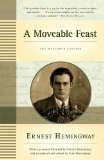 The trouble with posthumous publication is that you never know for sure if the book is the final result of the author’s intention because he or she wasn’t around during the final stages of editing. A Moveable Feast is Ernest Hemingway’s posthumous memoir of his early writing life and first marriage to Hadley Richardson in Paris in the 1920′s. Originally edited by his fourth wife, Mary Welsh, it was published in 1964, three years after Hemingway’s death. In 1979, Hemingway’s papers were opened to the public in the JFK Library and Boston, and critics began to question whether A Moveable Feast as the author intended it had been the version that was published.
The trouble with posthumous publication is that you never know for sure if the book is the final result of the author’s intention because he or she wasn’t around during the final stages of editing. A Moveable Feast is Ernest Hemingway’s posthumous memoir of his early writing life and first marriage to Hadley Richardson in Paris in the 1920′s. Originally edited by his fourth wife, Mary Welsh, it was published in 1964, three years after Hemingway’s death. In 1979, Hemingway’s papers were opened to the public in the JFK Library and Boston, and critics began to question whether A Moveable Feast as the author intended it had been the version that was published.
I read Paula McLain’s wonderful novel The Paris Wife last year, and I had determined at that time that I needed to read Hemingway’s memoir, which was McLain’s inspiration for her novel about the Hemingways as told from Hadley’s point of view. Hemingway begins his memoir after he and Hadley have already moved to Paris. He quickly befriends the other expatriate writers and artists in France, including Gertrude Stein, F. Scott Fitzgerald, Sylvia Beach (owner of the Shakespeare & Company bookstore), Ezra Pound, and James Joyce, among others. The book is really more of a series of vignettes rather than a straight narrative with a beginning, middle, and end, but it does provide an interesting insight into the expatriate writer’s life in the 1920′s, as well as some interesting insight into the other writers he encounters.
The writer who comes off the best in Hemingway’s memoir is Ezra Pound. Hemingway describes Pound as the most generous writer he has ever known, which is interesting because Pound’s reputation now has probably sustained the most damage after his support of Mussolini and Hitler, his World War II criticism of America and Franklin Delano Roosevelt, and his ultimate mental breakdown. One has the sense that Hemingway was attempting to rescue Pound’s reputation and point out that he was a good and generous man to young Hemingway, whatever his politics later became.
Scott Fitzgerald comes off much worse. Hemingway’s Fitzgerald is drunk, tedious, insecure, and silly. Hemingway doesn’t share much about Fitzgerald that casts him in a positive light, and curiously missing from the narrative is how Fitzgerald helped Hemingway edit The Sun Also Rises to make it much better book. He sharply criticizes Zelda for interfering with Scott’s ability to produce work, which is a criticism I feel is probably warranted. I do think Hemingway was probably telling the truth (mainly, as Huck would say) about Fitzgerald, but only half of the truth.

Hadley, Bumby, and Ernest Hemingway
The two standout characters in the memoir, at least to me, are Hemingway’s wife Hadley and their son Bumby (Jack Hemingway). One can’t read The Paris Wife without being angry at Hemingway for leaving Hadley for Pauline Pfeiffer, especially when Hadley loved Hemingway so much. However, in reading this memoir, I understood him a little better. He felt genuine remorse for what he had done to Hadley, and he accepted the blame, leaving some of the blame also to Pauline: “For the girl to deceive her friend was a terrible thing but it was my fault and blindness that this did not repel me” (219). Hadley, he explains, married again to “a much finer man than I ever was or ever could be” and Hemingway knew she was happy and ascribed none of the blame for their breakup to Hadley, even describing her as the heroine of A Moveable Feast and saying with confidence that Hadley wouldn’t mind the fictionalization of their time in Paris. What makes me sad is that Hadley died in 1979, so she perhaps never read the lengthy apology to her in this memoir as Mary Welsh cut it when she edited the book for publication. I think it might have made a difference to Hadley to know how Hemingway felt about what happened. He did truly love her, and one has the sense after reading A Moveable Feast that whatever happened in his love life after they divorced, he never really stopped loving Hadley.
Bumby comes across as good-natured and precocious, and I wondered if he were truly like that as a child or if Hemingway was ascribing those qualities to him as a proud father. The vignette added in this edition in which Bumby orders a beer at a café and somewhat scandalizes Scott Fitzgerald in so doing is funny and poignant. Bumby makes rather astute observations about Fitzgerald, self-control, and prostitutes that are far beyond his years to the point of being difficult to believe.
One has the sense that Hemingway chose to focus his memoir on this time in Paris because, despite the fact that he had yet to establish himself as the famous writer and persona he would later become, it was the happiest time in his life.
I haven’t read the edition edited by Mary Welsh, so all I really have to compare this memoir to is Paula McLain’s novel and the Wikipedia entry about the memoir with a list of the changes. This edition was edited by Hemingway’s grandson Seán Hemingway, son of Hemingway’s third son Gregory, with a foreword by Patrick Hemingway, Hemingway’s second and only surviving son. Seán Hemingway describes his restored edition as the original manuscript as the author intended it to be published and criticizes Mary Welsh’s editing as “changes that I strongly doubt would have been attempted by the editor had she required the author’s approval” (4) and even goes so far as to say that the “extensive edits Mary Hemingway made to this text seem to have served her own personal relationship with the writer as his fourth and final wife, rather than the interests of the book or of the author” (9), particularly with regard to his account of his breakup with Hadley and remarriage to Pauline. Seán Hemingway closes his introduction by saying,
For my grandfather, who was just starting out in those early years, Paris was simply the best place to work in the world, and it remained for him the city that he loved most. While you will not find goatherds piping their flocks through the streets of Paris anymore, if you visit the places on the Left Bank that Ernest Hemingway wrote about, or the Ritz Bar or Luxembourg Gardens, as I did with my wife recently, you can get a sense of how it must have been. You do not have to go to Paris to do this though; simply read A Moveable Feast, and it will take you there. (13)
Rating: 5 out of 5 stars
[image error]
Post © Dana Huff
A Moveable Feast, Ernest Hemingway

June 7, 2012
The House of Velvet and Glass, Katherine Howe
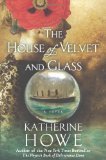 Katherine Howe’s debut novel, The Physick Book of Deliverance Dane, concerned a setting near her home in Marblehead and the Salem Witch Trials of 1692. Howe returns once again to Massachusetts of an earlier era, this time pre-WWI Boston. Sibyl Allston, daughter of a wealthy Salem sailor and a society gal, has lost her mother and younger sister in the sinking of Titanic. Her mother introduced her to the spiritualist gatherings at the home of the medium Mrs. Dee, and Sibyl continues to go in a desperate attempt to contact her mother and sister from beyond the grave. Discouraged by her inability to connect, she accepts a scrying glass from Mrs. Dee, and at first, she finds her attempts to use it unsuccessful, too. Her brother, sent home from Harvard in disgrace after he is caught in flagrante delicto with an actress in his rooms, brings his flamboyant girlfriend Dovie home, where she and Sibyl become unlikely friends. Dovie takes Sibyl to an opium den, where Sibyl is able to use her scrying glass for the first time. At first, she sees snatches of images she doesn’t understand, but once she realizes what she is able to see, Sibyl becomes desperate to know if what she sees in the scrying glass can be changed. The narrative is interspersed with flashbacks to her seventeen-year-old father’s sailing voyage to Shanghai and friendship with a young Chinese scholar and her mother and sister’s voyage on Titanic.
Katherine Howe’s debut novel, The Physick Book of Deliverance Dane, concerned a setting near her home in Marblehead and the Salem Witch Trials of 1692. Howe returns once again to Massachusetts of an earlier era, this time pre-WWI Boston. Sibyl Allston, daughter of a wealthy Salem sailor and a society gal, has lost her mother and younger sister in the sinking of Titanic. Her mother introduced her to the spiritualist gatherings at the home of the medium Mrs. Dee, and Sibyl continues to go in a desperate attempt to contact her mother and sister from beyond the grave. Discouraged by her inability to connect, she accepts a scrying glass from Mrs. Dee, and at first, she finds her attempts to use it unsuccessful, too. Her brother, sent home from Harvard in disgrace after he is caught in flagrante delicto with an actress in his rooms, brings his flamboyant girlfriend Dovie home, where she and Sibyl become unlikely friends. Dovie takes Sibyl to an opium den, where Sibyl is able to use her scrying glass for the first time. At first, she sees snatches of images she doesn’t understand, but once she realizes what she is able to see, Sibyl becomes desperate to know if what she sees in the scrying glass can be changed. The narrative is interspersed with flashbacks to her seventeen-year-old father’s sailing voyage to Shanghai and friendship with a young Chinese scholar and her mother and sister’s voyage on Titanic.
This book took me a while to get into, but about halfway into the book, the pace started picking up. Throughout, the descriptions are gorgeous, and I admired Howe’s ability to capture the early twentieth century well on many occasions. I liked the characters, and the setting was intriguing. The book has interesting things to say about all the what-ifs we wonder about in life, and also what our legacies might be if different choices are made. The old Calvinist thinking of early Massachusetts settlers is a surprising theme of the novel, as well. How much of our lives do we really have control over, and if we try to change events, can we really? Or is so much of what happens to us determined by Fate or God, or whatever you want to call the force of Predestination, that things will happen certain ways whether we try to intervene or not? The book does make one think about one’s place in the grand scheme of things.
Downton Abbey fans might like this book set in the same era in America. I think readers who enjoyed Howe’s first book will like this second one as well, though it is different from the first. Historical fiction fans who enjoy WWI-era novels will like it, too. Be patient with the first half, especially with the flashbacks that might not seem as if they are connected to the main narrative, as you will be rewarded once the book begins to coalesce during the second half. Enjoyable read!
Rating: 4 out of 5 stars
[image error]
Post © Dana Huff
The House of Velvet and Glass, Katherine Howe

May 13, 2012
Top Ten Favorite Quotes from Books
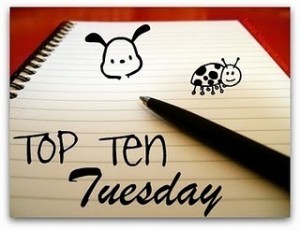 Busy week! I didn’t get to the Top Ten Tuesday on Tuesday at all. As soon as I finish this post, I’m off to pack up more books in preparation for next month’s move.
Busy week! I didn’t get to the Top Ten Tuesday on Tuesday at all. As soon as I finish this post, I’m off to pack up more books in preparation for next month’s move.
This week’s topic was irresistible, and I decided to participate even though I’d be late: Top Ten Favorite Book Quotes.
And as I sat there brooding on the old, unknown world, I thought of Gatsby’s wonder when he first picked out the green light at the end of Daisy’s dock. He had come a long way to this blue lawn, and his dream must have seemed so close that he could hardly fail to grasp it. He did not know that it was already behind him, somewhere back in that vast obscurity beyond the city, where the dark fields of the republic rolled on under the night. Gatsby believed in the green light, the orgastic future that year by year recedes before us. It eluded us then, but that’s no matter—to-morrow we will run faster, stretch out our arms farther…and one fine morning—
So we beat on, boats against the current, borne back ceaselessly into the past.—The Great Gatsby, F. Scott Fitzgerald
If people bring so much courage to this world the world has to kill them to break them, so of course it kills them. The world breaks every one and afterward many are strong at the broken places. But those that will not break it kills. It kills the very good and the very gentle and the very brave impartially. If you are none of these you can be sure it will kill you too but there will be no special hurry.—A Farewell to Arms, Ernest Hemingway
“Of course it is happening inside your head, Harry, but why on earth should that mean that it is not real?”—Harry Potter and the Deathly Hallows, J. K. Rowling
“Always,” said Snape.—Harry Potter and the Deathly Hallows, J. K. Rowling
Ships at a distance have every man’s wish on board. For some they come in with the tide. For others they sail forever on the same horizon, never out of sight, never landing until the Watcher turns his away in resignation, his dreams mocked to death by Time. That is the life of men. Now, women forget all those things they don’t want to remember, and remember everything they don’t want to forget. The dream is the truth. Then they act and do things accordingly.—Their Eyes Were Watching God, Zora Neale Hurston
“Come, gentle night, come, loving, black-brow’d night,/Give me my Romeo; and,/When he shall die,/Take him and cut him out in little stars,/And he will make the face of heaven so fine/That all the world will be in love with night/And pay no worship to the garish sun.”—Romeo and Juliet, William Shakespeare
“I can listen no longer in silence. I must speak to you by such means as are within my reach. You pierce my soul. I am half agony, half hope. Tell me not that I am too late, that such precious feelings are gone for ever. I offer myself to you again with a heart even more your own than when you almost broke it, eight years and a half ago. Dare not say that man forgets sooner than woman, that his love has an earlier death. I have loved none but you. Unjust I may have been, weak and resentful I have been, but never inconstant. You alone have brought me to Bath. For you alone, I think and plan. Have you not seen this? Can you fail to have understood my wishes? I had not waited even these ten days, could I have read your feelings, as I think you must have penetrated mine. I can hardly write. I am every instant hearing something which overpowers me. You sink your voice, but I can distinguish the tones of that voice when they would be lost on others. Too good, too excellent creature! You do us justice, indeed. You do believe that there is true attachment and constancy among men. Believe it to be most fervent, most undeviating, in F. W.
I must go, uncertain of my fate; but I shall return hither, or follow your party, as soon as possible. A word, a look, will be enough to decide whether I enter your father’s house this evening or never.”—Persuasion, Jane Austen
“Before I can live with other folks I’ve got to live with myself. The one thing that doesn’t abide by majority rule is a person’s conscience.”—To Kill a Mockingbird, Harper Lee
“It is only a novel… or, in short, only some work in which the greatest powers of the mind are displayed, in which the most thorough knowledge of human nature, the happiest delineation of its varieties, the liveliest effusions of wit and humour, are conveyed to the world in the best-chosen language.”—Northanger Abbey, Jane Austen
The mass of men lead lives of quiet desperation.—Walden, Henry David Thoreau
You know, I could really go on and on with this list. In fact, from my favorite book:
“My love for Linton is like the foliage in the woods: time will change it, I’m well aware, as winter changes the trees. My love for Heathcliff resembles the eternal rocks beneath: a source of little visible delight, but necessary. Nelly, I am Heathcliff!”—Wuthering Heights, Emily Brontë
[image error]
Post © Dana Huff
Top Ten Favorite Quotes from Books

May 4, 2012
Insurgent, Veronica Roth
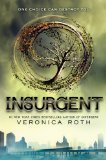 Tris Prior lives in a dystopian future Chicago divided by factions: Dauntless, who value bravery; Abnegation, who value selflessness; Erudite, who value education and intellect; Amity, who value love and friendship; and Candor, who value truth. Like other citizens in Chicago, Tris takes an aptitude test at the age of sixteen that will determine which faction she has an aptitude for. Tris’s test reveals that she is a rare individual with an equal aptitude for three factions: she is Divergent. The Divergent are considered dangerous and untrustworthy, and Tris is told to hide her test results at all costs.
Tris Prior lives in a dystopian future Chicago divided by factions: Dauntless, who value bravery; Abnegation, who value selflessness; Erudite, who value education and intellect; Amity, who value love and friendship; and Candor, who value truth. Like other citizens in Chicago, Tris takes an aptitude test at the age of sixteen that will determine which faction she has an aptitude for. Tris’s test reveals that she is a rare individual with an equal aptitude for three factions: she is Divergent. The Divergent are considered dangerous and untrustworthy, and Tris is told to hide her test results at all costs.
Veronica Roth’s novel Insurgent is the second in a planned trilogy, the first of which, Divergent, tells the story of Tris’s decision to choose Dauntless and her initiation into her faction. I would not recommend trying to read Insurgent without reading Divergent first. Roth wastes no time catching up readers who didn’t pick up the first book and dives into the story, instead. In fact, even though I read Divergent just a few months ago, I frequently found myself trying to remember who various minor characters were and how they fit into the story. You may want to stop reading now if you haven’t read the first novel.
In this novel, Tris and Tobias, formerly known as Four for the rare low number of four fears he has as an instructor in Dauntless, must pick up the pieces in the wake of Dauntless’s attack simulation, engineered by Erudite leaders, that obliterated most of Abnegation. The Dauntless faction members divide between loyalty to the Erudite and those refuse to ally themselves with Erudite. Tris, Tobias, and their friends consider those loyal to Erudite to be Dauntless traitors.
Tris learns that the Erudite engineered the Dauntless attack on Abnegation in order to prevent Abnegation from revealing a secret that will potentially destroy the factions and tear apart society. Meanwhile, she must also deal with her feelings of guilt over having to kill her friend, Will, when he was under the influence of the Dauntless attack simulation, the loss of her parents, and her growing feelings for Tobias. She also needs to come to terms with her Divergence.
This book was fast-paced and gripping. It is one of those rare sequels that improves upon the first book, which lays the ground work for this novel, while Insurgent exposes the reality of the society Tris lives in. There is rarely a moment of down time when Tris is not engaged in an epic life-or-death battle or speculating about the secret Abnegation was prepared to reveal before it was obliterated. I actually forced myself to slow down as I read. I could easily have read the book in one marathon sitting, and now I have to wait God knows how long for the final book. I really need to find out several things:
What does the world outside Chicago look like? I still don’t know, and I wanted to know that reading Divergent.
What happened? Chicago is part ruin, part rebuilt, with no lake Michigan, which is now just swamp. What kind of damage caused that?
The people outside Chicago, do they exist or not? If so, what do they live like?
I can’t begin to cast this thing, like I said I would try to do with books I review. I have just spent an hour trying to find someone to play Tris, and no one looks like her. Honestly, casting Four (much prefer the nickname to Tobias, which is what Tris mostly calls him in this book) would be even more difficult. I don’t even want to go down that Google Image Search rabbit hole.
Rating: 5 out of 5 stars
[image error]
Post © Dana Huff
Insurgent, Veronica Roth

May 2, 2012
Top Ten Tuesday: Books to be Made into Movies
 I am having trouble with the plugin that handles Amazon links, but I decided I should publish this anyway before the expiration date on this topic is too long past.
I am having trouble with the plugin that handles Amazon links, but I decided I should publish this anyway before the expiration date on this topic is too long past.
I like this week’s Top Ten Tuesday topic. Which books should be made into movies? Here’s my list:
The Night Circus , Erin Morgenstern. I think this book would be great in Tim Burton’s hands. It wasn’t my favorite read, but it has such strong imagery that it’s begging to be made into a movie. I think I heard somewhere that it actually has been optioned.
Outlander , Diana Gabaldon. It would probably only work as a miniseries, and God knows who they would cast, but it’s such a great series. I’d love to see the books made into films à la The Thorn Birds.
Looking for Alaska , John Green. I didn’t like this book a whole lot, but I could see it making a pretty good teen movie like Some Kind of Wonderful or Pretty in Pink .
Miss Peregrine’s Home for Peculiar Children , Ransom Riggs. Another one with a lot of visual imagery and some great humor that would be fun to watch.
The Eyre Affair, Jasper Fforde. I’ve actually talked about this one before.
The Catcher in the Rye , J. D. Salinger. It would be tricky to pull off, but I think if the director did internal monologue voiceovers, it might work.
American Gods , Neil Gaiman. This could be a sprawling sort of epic with the right cast and script.
The Woman in White, Wilkie Collins. If this has been made into a successful movie, then I haven’t heard about it, but it would be a great gothic tale.
Wicked, Gregory Maguire. Why not? They brought it to Broadway. Would be fun to cast Wizard of Oz lookalikes where possible, too.
King Lear , William Shakespeare. Seriously, why hasn’t one of Shakespeare’s greatest plays been made into a huge movie. They’ve done just about every other major play and even minor ones. I have seen filmed stage versions of this, and there’s a good PBS one, but not exactly major motion pictures.
What about you? What books do you think should be made into movies?
[image error]
Post © Dana Huff
Top Ten Tuesday: Books to be Made into Movies

April 27, 2012
Persepolis, Marjane Satrapi
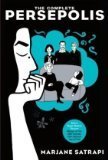 The first time I ever heard anything about the country of Iran was when I was in second grade. Americans had been taken hostage at the American Embassy in Tehran. We wrote letters to the hostages, and I remembered very clearly that a boy in my class wrote in his letter, “I hope you don’t get shot.” Miss Johnson, my teacher, made him change it because, she said, while she was sure they would appreciate his hoping they wouldn’t get shot, he shouldn’t remind them of the possibility in a letter. They were already scared enough. I remembered thinking that these people must be crazy to kidnap people they didn’t know for no reason I could understand. I think a lot of Americans came to view Iranians as crazy fundamentalists, and it was easy to lump the entire country together under that label. Persepolis is a memoir by Marjane Satrapi, who experienced what it was like to live in Iran during the Islamic Revolution. She paints a different image of Iran and Iranians than many Americans my age and younger grew up seeing. She describes what it was like to feel hopeful when the Shah was deposed, only to find the revolution was not what she and her family expected, and in many ways, their lives were worse. Satrapi suddenly had to wear a veil to school. Satrapi was outspoken and frequently courted trouble. When she was fourteen, her parents sent her to school in Austria. She came back to Iran at the age of eighteen confused about who she was: she didn’t feel completely Iranian because her beliefs were out of step with those of her more traditional friends, but she didn’t feel Western, either.
The first time I ever heard anything about the country of Iran was when I was in second grade. Americans had been taken hostage at the American Embassy in Tehran. We wrote letters to the hostages, and I remembered very clearly that a boy in my class wrote in his letter, “I hope you don’t get shot.” Miss Johnson, my teacher, made him change it because, she said, while she was sure they would appreciate his hoping they wouldn’t get shot, he shouldn’t remind them of the possibility in a letter. They were already scared enough. I remembered thinking that these people must be crazy to kidnap people they didn’t know for no reason I could understand. I think a lot of Americans came to view Iranians as crazy fundamentalists, and it was easy to lump the entire country together under that label. Persepolis is a memoir by Marjane Satrapi, who experienced what it was like to live in Iran during the Islamic Revolution. She paints a different image of Iran and Iranians than many Americans my age and younger grew up seeing. She describes what it was like to feel hopeful when the Shah was deposed, only to find the revolution was not what she and her family expected, and in many ways, their lives were worse. Satrapi suddenly had to wear a veil to school. Satrapi was outspoken and frequently courted trouble. When she was fourteen, her parents sent her to school in Austria. She came back to Iran at the age of eighteen confused about who she was: she didn’t feel completely Iranian because her beliefs were out of step with those of her more traditional friends, but she didn’t feel Western, either.
The version I read contains the complete graphic novel, spanning Satrapi’s life from the late 1970′s to the mid-1990′s. I liked the artwork. It was simple but effective, and I found Satrapi’s story so captivating that I read the novel in a matter of hours (although it is true that graphic novels are quicker to read). I have not read many graphic novels. In fact, this is only my second, the other being Maus I: A Survivor’s Tale: My Father Bleeds History. I didn’t like Maus all that much, and I have never been much of a comic book reader, so I think I told myself I didn’t like graphic novels. This graphic novel was excellent, though. I found Satrapi’s description of life in Iran and her parents interesting. I think growing up when I did, it was easy to see the people of Iran as “the enemy” and to forget they are not terribly different from us, and what this book does brilliantly is expose that prejudice to the reader. Reading this memoir, I do not have the sense it was written for an Iranian audience. It feels more like it was meant to educate Westerners, and it certainly changed my perspective. We have our own religious extremists here in America, but the difference is that our government allows dissent, and we’re not yet living in the Republic of Gilead.* I enjoyed the fact that the memoir was an unflinchingly honest examination of Satrapi’s coming of age, but also not without quite a fair amount of humor, even the face of difficult circumstances and devastating events. Ultimately, Satrapi’s memoir is the story of how she discovered who she is and what she wanted. I would recommend it to anyone who thinks they don’t like graphic novels. Anyone who already enjoys graphic novels will love this book.
*A reference to the government established by the Religious Right in Margaret Atwood’s novel The Handmaid’s Tale.
Rating: 5 out of 5 stars
I read this novel to fulfill the Graphic Novels and Manga category of the Mixing it Up Challenge.
[image error]
Post © Dana Huff
Persepolis, Marjane Satrapi





